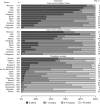Differences in the risk of cervical cancer and human papillomavirus infection by education level
- PMID: 19654578
- PMCID: PMC2736843
- DOI: 10.1038/sj.bjc.6605224
Differences in the risk of cervical cancer and human papillomavirus infection by education level
Abstract
Background: Cervical cancer risk is associated with low education even in an unscreened population, but it is not clear whether human papillomavirus (HPV) infection follows the same pattern.
Methods: Two large multicentric studies (case-control studies of cervical cancer and HPV prevalence survey) including nearly 20 000 women. GP5+/GP6+ PCR was used to detect HPV.
Results: Education level was consistently associated with cervical cancer risk (odds ratio (OR) for 0 and >5 years vs 1-5 years=1.50, 95% confidence interval (CI): 1.25-1.80 and 0.69, 95% CI: 0.57-0.82, respectively, P for trend <0.0001). In contrast, no association emerged between education level and HPV infection in either of the two IARC studies. A majority of the women studied had never had a Pap smear. The association between low education level and cervical cancer was most strongly attenuated by adjustment for age at first sexual intercourse and first pregnancy. Parity and screening history (but not lifetime number of sexual partners, husband's extramarital sexual relationships, and smoking) also seemed to be important confounding factors.
Conclusion: The excess of cervical cancer found in women with a low socio-economic status seems, therefore, not to be explained by a concomitant excess of HPV prevalence, but rather by early events in a woman's sexually active life that may modify the cancer-causing potential of HPV infection.
Figures



References
-
- Anh PT, Hieu NT, Herrero R, Vaccarella S, Smith JS, Thuy NT, Nga NH, Duc NB, Ashley R, Snijders PJ, Meijer CJ, Munoz N, Parkin DM, Franceschi S (2003) Human papillomavirus infection among women in South and North Vietnam. Int J Cancer 104: 213–220 - PubMed
-
- Banura C, Franceschi S, van Doorn LJ, Arslan A, Wabwire-Mangen F, Mbidde EK, Quint W, Weiderpass E (2008) Infection with human papillomavirus and HIV among young women in Kampala, Uganda. J Infect Dis 197: 555–562 - PubMed
-
- Bardin A, Vaccarella S, Clifford GM, Lissowska J, Rekosz M, Bobkiewicz P, Kupryjanczyk J, Krynicki R, Jonska-Gmyrek J, Danska-Bidzinska A, Snijders PJ, Meijer CJ, Zatonski W, Franceschi S (2008) Human papillomavirus infection in women with and without cervical cancer in Warsaw, Poland. Eur J Cancer 44: 557–564 - PubMed
-
- Bayo S, Bosch FX, de Sanjose S, Munoz N, Combita AL, Coursaget P, Diaz M, Dolo A, van den Brule AJ, Meijer CJ (2002) Risk factors of invasive cervical cancer in Mali. Int J Epidemiol 31: 202–209 - PubMed
-
- Chaouki N, Bosch FX, Munoz N, Meijer CJ, El Gueddari B, El Ghazi A, Deacon J, Castellsague X, Walboomers JM (1998) The viral origin of cervical cancer in Rabat, Morocco. Int J Cancer 75: 546–554 - PubMed
Publication types
MeSH terms
LinkOut - more resources
Full Text Sources
Medical
Research Materials
Miscellaneous

